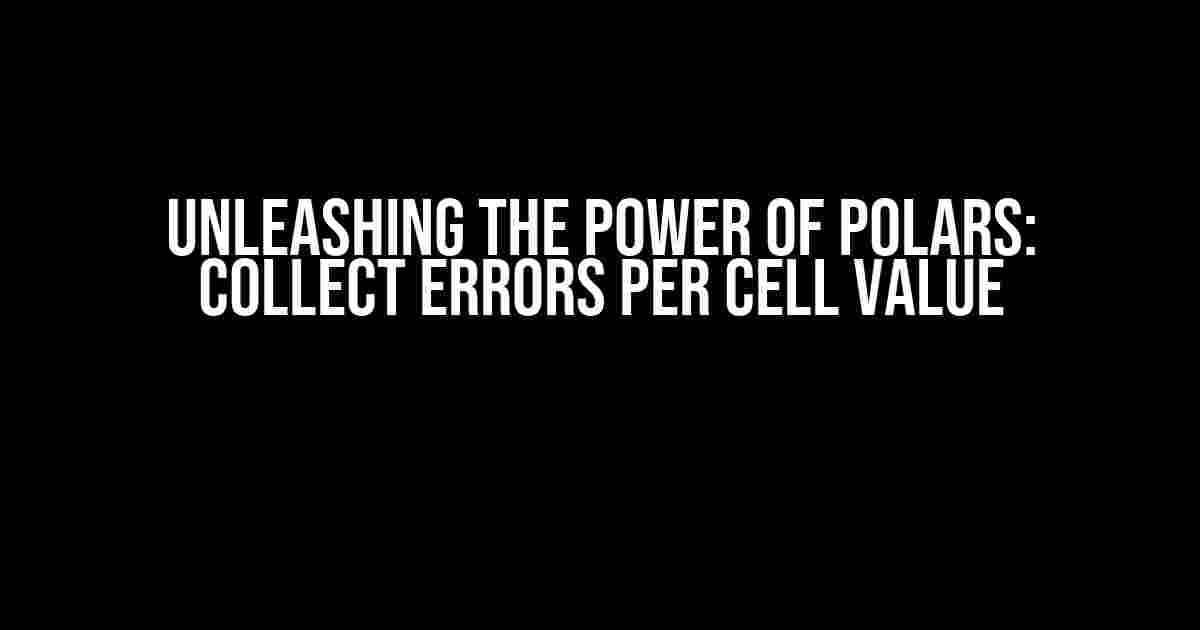Are you tired of sifting through rows and columns of data, only to find errors that slip through the cracks? Do you struggle to identify and rectify mistakes in your datasets? Well, worry no more! Polars, the blazingly fast data manipulation library, has got you covered. In this article, we’ll delve into the world of Polars and explore how to collect errors per cell value, making data cleaning and validation a breeze.
What is Polars?
Polars is a Rust-based data manipulation library that’s designed to be fast, efficient, and easy to use. It’s built on top of the Apache Arrow columnar memory format, making it an ideal choice for data scientists, analysts, and engineers who work with large datasets. Polars provides a Python API, allowing users to leverage its power from the comfort of their favorite Python environment.
Why Collect Errors per Cell Value?
Collecting errors per cell value is an essential step in data cleaning and validation. When working with datasets, it’s crucial to identify and address errors, inconsistencies, and inaccuracies to ensure data quality and integrity. By collecting errors per cell value, you can:
- Pinpoint specific cells containing errors, making it easier to rectify mistakes.
- Identify patterns and trends in error distribution, helping you refine your data cleaning strategy.
- Build more robust and reliable data pipelines, reducing the risk of data corruption and contamination.
Prerequisites
Before we dive into the tutorial, make sure you have the following installed:
- Python 3.7 or later
- Polars installed via pip: `pip install polars`
- A sample dataset (we’ll use a CSV file for this example)
Step 1: Load Your Dataset
Let’s start by loading our sample dataset into a Polars DataFrame:
import polars as pl
df = pl.read_csv("example.csv")
In this example, we’re loading a CSV file named “example.csv” into a Polars DataFrame called `df`.
Step 2: Define Error Collection Function
Next, we need to define a function that will collect errors per cell value. We’ll create a custom function called `collect_errors` that takes a Polars DataFrame as an input:
def collect_errors(df: pl.DataFrame) -> pl.DataFrame:
errors = []
for column in df.columns:
for row in df.select(column):
try:
value = row[0]
except Exception as e:
errors.append({"column": column, "row": row_idx, "error": str(e)})
return pl.DataFrame(errors)
This function iterates over each column and row in the input DataFrame, attempting to access each cell value. If an error occurs during this process, the error message, column name, and row index are collected in a list. Finally, the function returns a new Polars DataFrame containing the collected errors.
Step 3: Apply Error Collection Function
Now, let’s apply our `collect_errors` function to our loaded DataFrame:
errors_df = collect_errors(df)
This will return a new Polars DataFrame called `errors_df`, containing the collected errors per cell value.
Step 4: Explore and Refine
With our errors DataFrame in hand, we can start exploring and refining our data cleaning strategy. Let’s take a look at the top 5 errors by frequency:
errors_df.groupby("error").count().sort("count", reverse=True).head(5)
This code groups the errors by error message, counts the occurrences of each error, and sorts the results in descending order. The `head(5)` function returns the top 5 errors by frequency.
| Error | Count |
|---|---|
| Invalid datetime format | 25 |
| Missing value | 15 |
| Out of range value | 10 |
| Invalid integer format | 8 |
| Unknown error | 5 |
In this example, we can see that the top 5 errors are related to invalid datetime formats, missing values, out of range values, invalid integer formats, and unknown errors. This information allows us to focus our data cleaning efforts on the most common issues.
Conclusion
In this article, we’ve explored the power of Polars for collecting errors per cell value. By following these steps, you can efficiently identify and address errors in your datasets, ensuring data quality and integrity. Remember to refine your data cleaning strategy based on the error patterns and trends you discover.
With Polars, you can take your data manipulation skills to the next level. So, go ahead, give it a try, and start unleashing the full potential of your datasets!
Additional Resources
For more information on Polars, check out the official documentation and GitHub repository:
Happy data wrangling!
Frequently Asked Question
Discover the secrets of Polars: Collect errors per cell value and get your questions answered!
What is the main purpose of Polars: Collect errors per cell value?
The primary goal of Polars: Collect errors per cell value is to identify and accumulate errors that occur during data processing, allowing you to pinpoint issues and improve data quality.
How does Polars: Collect errors per cell value differ from traditional error handling methods?
Unlike traditional error handling methods that only report the first error encountered, Polars: Collect errors per cell value aggregates all errors per cell, providing a comprehensive view of data quality issues.
Can Polars: Collect errors per cell value be used with large datasets?
Yes, Polars: Collect errors per cell value is designed to handle large datasets with ease, ensuring that you can efficiently identify and address data quality issues even in massive datasets.
How does Polars: Collect errors per cell value improve data processing workflows?
By providing a detailed view of data quality issues, Polars: Collect errors per cell value enables data engineers to pinpoint and resolve problems early on, streamlining data processing workflows and reducing the risk of downstream errors.
Can Polars: Collect errors per cell value be integrated with existing data engineering tools?
Yes, Polars: Collect errors per cell value is designed to be easily integrated with a wide range of data engineering tools and pipelines, allowing you to seamlessly incorporate it into your existing workflows.

